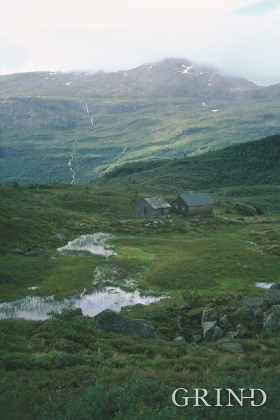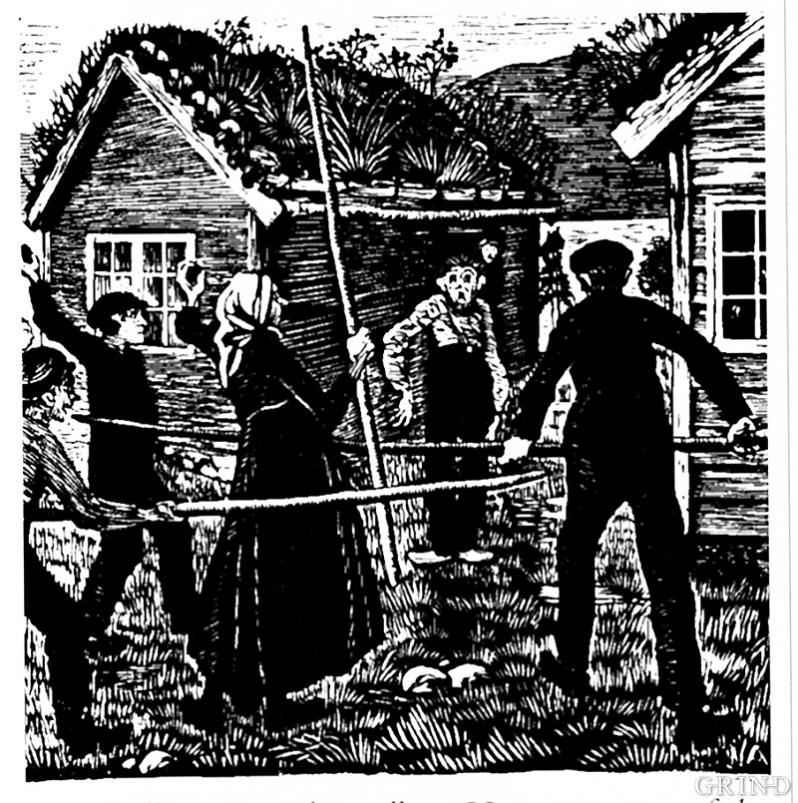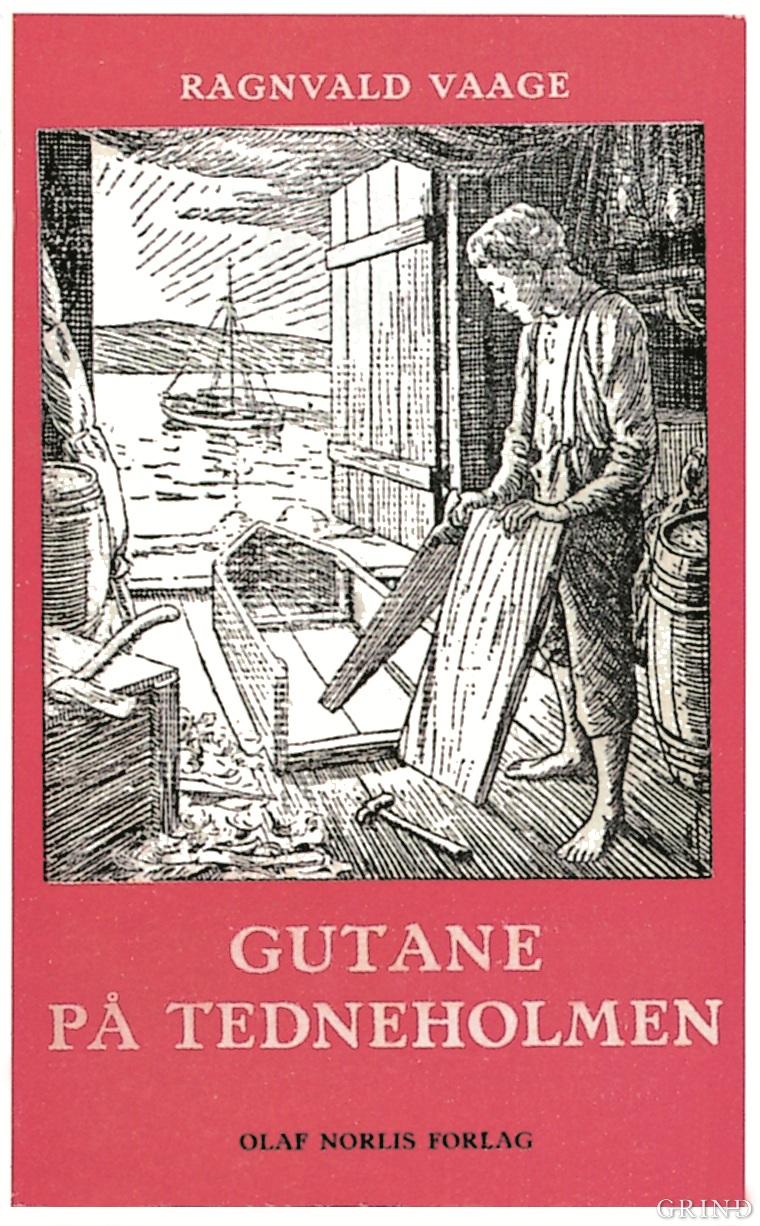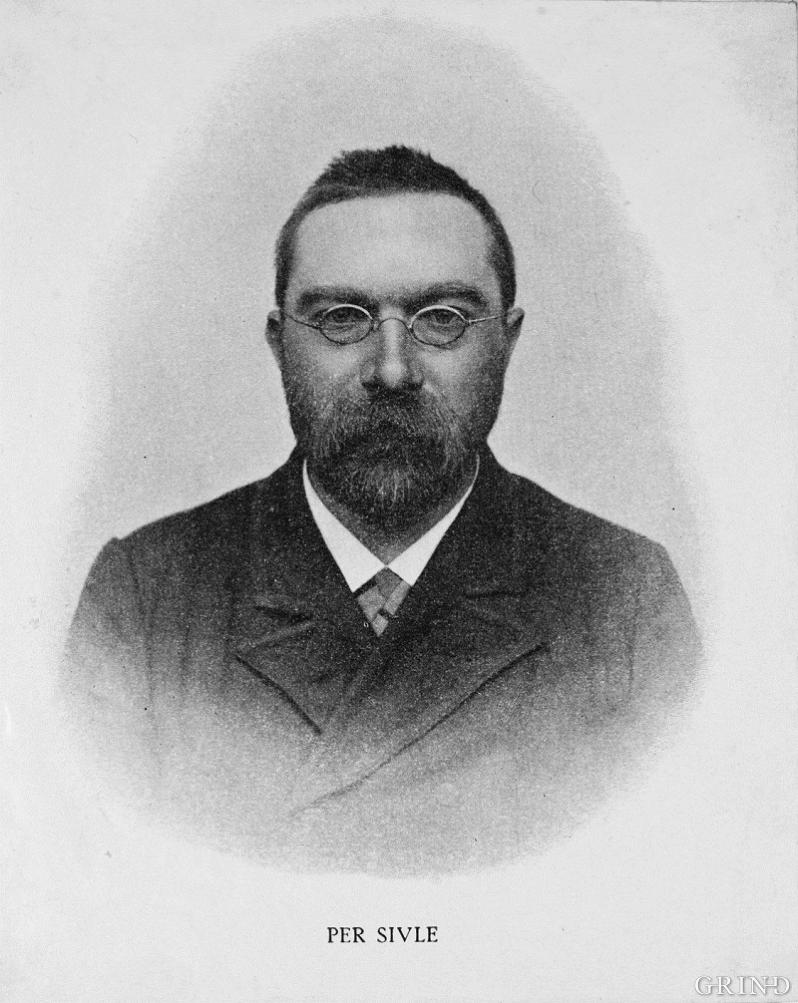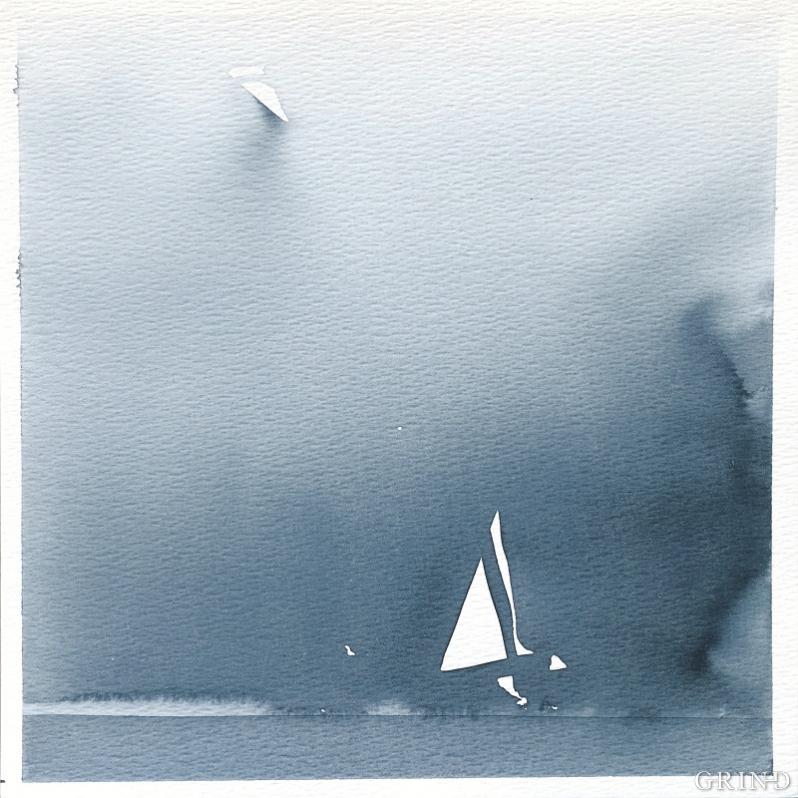Published: 19.05.2009 | Author: Idar Stegane
(Svein Nord).
Now the evening rises in the western skies. It treads with light footsteps
through the hamlet and the shadowy hill hangs between.
A whisper runs through the thicket and the heather, and the songthrush changes sound and
sings with a hidden quivering farewell tune under its strings”. .
This is one of the classics in the Norwegian book canon, the lyric poet Olav Nygard from Modalen who captivates us with this wistful tone on a landscape where he feels at home, but where, in many ways, he feels himself a captive, misunderstood and little heeded as he was by his contemporaries. The imagery and the linguistic richness links Nygard closely to the landscape. The experience of nature by our lyric poets also gave our own appreciation of the landscape a deeper resonance.
People and the landscape
The landscape and natural forces can also be in opposition to one another. Sverre’s saga tells us, concisely and dramatically, of the battle King Sverre and his men fought against an impassable terrain and a life-threatening snowstorm in the mountains between Voss and Vik, in the same way as the mountains and the snowstorm threatened life in “The Storm”; one of the chapters in Sjur Bygd's novel “The Battlefield”.
It is also Nature and the landscape with wind and weather which is decisive for comfort and progress, when the academic public servants, Bishops Brun Pavels and Neumann are travelling through the district on a visitation. The bishopric dean – at that time - Johan Nordahl Brun describes the landscape in Mjeldalen and at Gjerstad on Osterøy as beautiful, on a visitation to Hosanger in 1795. Bishop Neumann does the same a generation later.
To describe a landscape as “beautiful” is a modern invention, and developed, first and foremost by the Romantics. A fictional text which describes the county, in fact the whole of western Norway, “The County of Bergen” by J.A.Welhaven (1807-1873) from his collection of “Poems” (1838) is just such a romantic poem. The poem’s narrator sits in the capital and conjures up a memorial, in highly romantic images and allegories, in the grip of longing for the landscape of childhood in the west:
At the gate of my Eden, there is a Giant present,
Wild glaciers split the clouds in the belt of power
Embracing the bold heroes,
Has the Goddess spun the flower of the rose
But Welhaven also has a sharply critical eye for the landscape and the people in his “Images from the Bergen Coast”, partly coloured by the writer’s refined and urban cultural horizon. His descriptions of the land around Bergen are marked by sarcasm rather than knowledge. And so we, literally speaking, are out in the regional landscape.
“The very wonderful Hardanger”
As a travel destination and an attraction, Hardanger has been created by the Romantics; in the literary dimension by Henrik Wergeland (1808-1845) and Andreas Munch (1811-1884). In Wergeland’s great collection of poems, “The English Pilot” (1844) we find the poem, “Hardanger”. Three of four stanzas end up with the words: “…. in the wonderful Hardanger”, a repetition which is further emphasised in the end by the words: “ …. Very wonderful Hardanger”. In the next poem the narrative uses the same expression: “There on one of these peninsulas/ in the wonderful Hardanger” .
One of these peninsulas can be the headland with the church in Tidemand and Gude’s painting: “A Wedding Party in Hardanger”. For this Andreas Munch wrote the poem: “The Wedding Party” /(New Poems, 1851) which also helped to put Hardanger on the romantic literary map: “There blows a sparkling summer breeze/warm across the waters of the Hardanger Fjord”.
If Hardanger with its fruit blossom still has a romantic aspect in the consciousness of the tourist, this aspect disappeared rapidly out of the literature. The first person to assault this picture was Hans E. Kinck (1865-1926). He was also a passer-by, since he belonged to the class of public servants and came to Strandebarm as a small boy with his family. His interest for people in the rural areas was of a psychological and social nature. He did not lay on any beautified portrait as Munch had done, but put an emphasis on portraying the way people acted and their inner life in connection with their struggle to make a living and a cultural life which was created under hard or rather prosaic conditions. It is natural enough that his poetry gave the impression of not knowing rural folk from the inside. But often his Baroque way of presenting things was taken far too literally.
On the other hand the writers from Sørfjord, Lars Jaastad (1871-1926) and Gro Holm (1878-1951) knew the rural environment from the inside. With his novel, “Crofter and farmer” (1911) Jaastad tried to change the idea that in Western Norway there was little difference between the two groups (crofter and farmer). In his subsequent books came the modern industrial district into the literature. The industrial town of Røysnes (Linde and Røysnes,1912) can be identified as the town of Odda. The crofter lad became a factory worker and came out on strike and got into political conflicts. The conflicts came dramatically to light.
Gro Holm’s writing is also built up around social conflict, and here too Sørfjord is the locale for the action. In the trilogy on the “Løstols Folk” (“Sorrow”(1932), “The Landed Inheritance” (1933) and “Circumstances” (1934) she brings into farming literature a female principal character who takes over leadership in the village. We also encounter tourism in a pre-industrial Odda, especially the coaching traffic. And Holm exposes the rear view of things: Both the farmer and the horse move away from working on the farm, and the incomes from tourist traffic soon go to drinking rather than for making a living. Later on Holm wrote the novel, “The white coal” (1936), which has as its departure point from working on the waterfalls and working in the factory at Odda. Together Jaastad and Holm brought into Hardanger literature new social and landscape formations which arrived with the development of industry.
In our own times to the natural and cultural landscapes of Hardanger occupy a central position in poetry, as in the lyrics of Olav H. Hauge. Here are images from the mountains and the fjords, from plant and animal life, from working life and days of celebrations, very often named places and landscapes. Many times Hauge’s motifs are those of travels by sea or by land, and not always at modern speeds or using resources. As in “Horses and Travellers” :
“Horses and travellers look for
Water troughs along the roadside.
What would they do with
Filling stations?”
Sunnhordaland
Jaastad and Holm’s writings are an extension of the domestic writing of the 1880s. Here Jens Tvedt (1857-1935) of Kvinnherad is reckoned as the key writer. Tvedt got the material for his books from the rural districts of Sunnhordland. The scenes in his novella and novels were from the start naturally open, and could appear revealing. Tvedt portrayed down-and-out folk, both economically and socially, and he was not liked for it because people thought they recognised themselves and they felt they had been denounced. But Tvedt created heroes from the lowest levels in the society of the poor. In some of his best novels he lets women take over the lead, and he has been successful in this in his books on the crofter girl Madli in “Madli and the apple-tree” (1900) and “God’s maple-tree” “1906). Madli’s enduring strength is based on two things: her working conditions and her use of language; she develops both in and from the Sunnhordland environment that Tvedt places her in.
Tvedt was the starting point for a rich literature in Sunnhordland. If the domestic writers had any education, it was from the Teacher’s Training College like Tvedt had, or it was from the local college as Ragnald Vaage (1889-1966) from Sunde had. Vaage wrote poems, stories and children’s books; he was a farmer and a public speaker. His poems can be perceptions from the landscape and Nature. Quite frequently he starts off with working life and public life, and they are often humorous.
Vaage was one of those who followed up children’s literature in the New Norwegian language, with seven books, 1923 to 1960. In the classic: “The Boys at Tedneholmen”, children are portrayed on their own premises.
The main character, Torvall finds many adults as being authoritarian, stupid and inconsistent, and the reader must agree with him in this. The action takes place in a rural area in Sunnhordland at the beginning of the 20th century. A central writer on popular life was Arne Vågen (the pseudonym of Sigurd Segelcke Meidell 1878-1968). Vågen wrote a series of popular novels based on the environment and landscape in the area around Rosendal. Some of his book titles reflect this directly: “Lasse Aga” (1941), “The Waves in Oldersund” (1942) and “Spring Awakening in Nesvågen” (1959).
Johannes Heggeland (born in 1919) is a farmer from Tysnes and is responsible for a whole literature on its own with his bulky works, stories and novels for both children and adults. Heggland’s books operate in the landscape of Sunnhordland both in the past and in the present. The children’s’ books are historical tales, they have exciting plots, there are conflicts and reconciliation between the local residents and incomers, there are moral digressions - these historical books in particular have been popular reading. There are also his books for adults, not least the most recent ones.
One strange bird, an outsider in this landscape was the realist Torgborg Nedreaas (1906-87) who lived as a child at Stord in the summer. She only moved back in the 1940s; she lived there with her sons and her mother during the war and fed her family by fishing and writing short stories for the weekly magazines. In the autumn of 1945 two collections of novellas came out. Sometimes you can recognise the Sunnhordland dialect and various things in the environment. Nedreaas was active politically in the Stord Communist Party and in the newspaper: “Sunnhordland Labour Party Journal” just after the war. In an excellent essay: “Norway in a mussel-shell” (1954 printed in the book: Winter-Spring 1982) she wrote that Stord is: “the whole of Norway in total, on one island with a circumference of 70 kilometres, surrounded by 223 little islands in every shape and size.”
There have been a series of names in children’s literature in Sunnhordland. These are: Einar Økland (Born 1940), Ingvar Moe (1936-1993). Oskar Stein Bjørlykke (born 1939), Sigbjørn Heie (born 1945), Per Olav Kalvestad (born 1947), Ragnar Hovland (born 1952), Rune Belsvik (born 1956), Helga Gunnerius Eriksen (born 1959) and the pseudonym John Donner. In many ways a foundation for Norwegian children’s literature has been Økland’s books, and they in their turn can be traced back to the same tradition as “The Boys at Tedneholmen”. They are books written on the children’s premises. Whatever happens or whatever is seen is experienced, understood and interpreted by children. Writers from Sunnhordland with the addition of Arild Stubhaug (born 1948), Karin Moe (born 1945) and Lars Amund Vaage (born 1952) account for an important part of the total Norwegian authorship of today. Some of those who write have nothing obvious to do with the landscape, but a good many do have. Økland’s “Amateur Album” (1969) which he himself calls a “landscape novel”, corresponds with a tendency in contemporary literature to bring people to live in relation to their environment: so-called “environmental literature” was a relevant literary concept. Then from Strandebarm came one of Norway’s most prominent writers amongst the younger generation and that is Jon Fosse (Born 1959). Fosse writes articles about literature, children’s books, lyrics, novels and especially plays. He has an unusual style; he delves deep into the thought processes of his characters in the linguistic expression itself, in the sentence construction, rhythms and repetitive monotony. Landscape and people are as one, for example in the novel: “The Boat house” (1989).
Nordhordaland and Midthordaland
If we then move our perspective slightly to the north, we shall find a broad cultural historical and social portrayal from the coast in the work of Kåre Fasting (born 1907). Fasting wrote a series of entertaining novels. His portrayals of fisher folk in Øygarden is his first book: “The Sea gave” (1935) are particularly lively. The direct and unadorned portrayal can put one in mind of a better known tale of fisherfolk in the Bergen area, that is Amalie Skram's “Sjur Gabriel” (1887) in the series on “The Folk of Hellemyr”. There we get a lifelike impression of how it was to get to and from the city in olden times, even although today these are regarded as pretty short distances. And in the plays of Gerhard Garatun-Tjeldstø (born 1901) the drama is linked to the environment in outer districts. On the other hand, the background of the writer Pål Sundvor (1920-1992) comes from further inland. Sundvor was from Sævareid in Fusa. He wrote short stories about young people and novels. His first book in 1947 was a children’s book.
Ola Mjanger (1889-1968) from Masfjorden and Anton Solheim (born 1897) from Austrheim also wrote children’s’ books. They wrote about lively and resourceful children from rural areas, in the tradition which had started with the stories for small boys by the author Rasmus Løland from Ryfylke. Nils Bjørgås (born 1910) from Voss did the same in his trilogy on: “Vetle-Jens (1948-1950). “Bjørgås is more plausible for his young readers than is the custom in Norwegian children’s literature”, says Sonja Hagemann. Erna Osland, a teacher from Masfjorden and Bente Bratlund Mæland from Os are promising new writers of books for young people.
The novelist from between the Wars, Kristian Matre (1877-1943) came from Lindås. Several of the six novels (1926-1934) are of cultural historical value, and they are also of psychological interest in connection with religious problems.
But Nordhordland has first and foremost one great writer, and that is the lyric poet, Olav Nygård (1884-1924) from Modalen. His use of imagery and linguistic richness links him to the landscape, as we meet him at the entrance to this article.
The landscape also made its mark on the poems of another well-known lyric poet from Nordhordland, Aslaug Låstad Lygre (1910-1966) from Lindås who wrote this well known song to the music of Geirr Tveitt: “We shall not sleep away the summer night/ it is too light for that”.
The rural districts of Voss
Eastwards towards Voss it is worth making a literary stop-over a Bolstadøyri. Knut Horvei (1893-1984) was an outstanding writer from the years between the Wars to the 1970s, with novels and experimental plays, preferably with historical or even mystical themes.
An important Norwegian prose-writer from the same district, from Evanger, is Bjørn Rongen (1906-1983) who in short stories and novels was pre-occupied with questions concerning modern society. The best known is a series of novels which are of special interest for travel and transport, the trilogy on the building of the Oslo-Bergen railway: Train across the plateau (1956), In the shadow of the glacier (1957) and Ready for the train (1958).
But the language and the people of the Voss rural districts were first and foremost rendered immortal by Per Sivle (1857-1904) and his narrator Kolbein Hausa I Tall Stories from Voss (1887) and More Tall Stories from Voss (1894). Sivle was an innovator in many areas, social poetry, political, historical and personal lyrics; and through his collection: Stories (1887) which was also located in the landscape of Voss, he, together with Rasmus Løland, was the founder of children’s literature in the New Norwegian language. Voss also has important writers after Sivle too. From a social history and cultural history point of view, the novels and short stories from Mykdalen, of Sjur Bygd (1889-1985) are interesting. And he is most interested in the people, the psychological relation between the mind and external conditions. A rich and graphic use of imagery connects people to nature. Images of nature together with human activity are also important elements of the poetry anthologies of Signe Seim (born 1929). Johannes Gjerdåker (born 1934) turns in his poems back to history and to the cultural traditions, in a classic stanza form like the sonnet. Also from Nordhordland and the Voss region come the lyric poets Åse Lilleskare Faugstad (born 1941), Libsbet Lid Venås (born 1937) and Magne Myhra (born 1930), as well as the novelist Brita Lid (1893-1981)
- Stegane, I. red. (1978) Sunnhordlandsdiktarar. Oslo, Samlaget.

